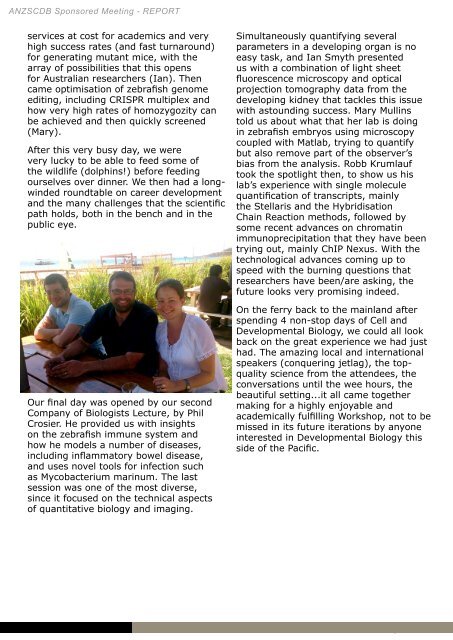2014-ANZSCDB-Summer-newsletter
2014-ANZSCDB-Summer-newsletter
2014-ANZSCDB-Summer-newsletter
Create successful ePaper yourself
Turn your PDF publications into a flip-book with our unique Google optimized e-Paper software.
<strong>ANZSCDB</strong> Sponsored Meeting - REPORT<br />
services at cost for academics and very<br />
high success rates (and fast turnaround)<br />
for generating mutant mice, with the<br />
array of possibilities that this opens<br />
for Australian researchers (Ian). Then<br />
came optimisation of zebrafish genome<br />
editing, including CRISPR multiplex and<br />
how very high rates of homozygozity can<br />
be achieved and then quickly screened<br />
(Mary).<br />
After this very busy day, we were<br />
very lucky to be able to feed some of<br />
the wildlife (dolphins!) before feeding<br />
ourselves over dinner. We then had a longwinded<br />
roundtable on career development<br />
and the many challenges that the scientific<br />
path holds, both in the bench and in the<br />
public eye.<br />
Our final day was opened by our second<br />
Company of Biologists Lecture, by Phil<br />
Crosier. He provided us with insights<br />
on the zebrafish immune system and<br />
how he models a number of diseases,<br />
including inflammatory bowel disease,<br />
and uses novel tools for infection such<br />
as Mycobacterium marinum. The last<br />
session was one of the most diverse,<br />
since it focused on the technical aspects<br />
of quantitative biology and imaging.<br />
Simultaneously quantifying several<br />
parameters in a developing organ is no<br />
easy task, and Ian Smyth presented<br />
us with a combination of light sheet<br />
fluorescence microscopy and optical<br />
projection tomography data from the<br />
developing kidney that tackles this issue<br />
with astounding success. Mary Mullins<br />
told us about what that her lab is doing<br />
in zebrafish embryos using microscopy<br />
coupled with Matlab, trying to quantify<br />
but also remove part of the observer’s<br />
bias from the analysis. Robb Krumlauf<br />
took the spotlight then, to show us his<br />
lab’s experience with single molecule<br />
quantification of transcripts, mainly<br />
the Stellaris and the Hybridisation<br />
Chain Reaction methods, followed by<br />
some recent advances on chromatin<br />
immunoprecipitation that they have been<br />
trying out, mainly ChIP Nexus. With the<br />
technological advances coming up to<br />
speed with the burning questions that<br />
researchers have been/are asking, the<br />
future looks very promising indeed.<br />
On the ferry back to the mainland after<br />
spending 4 non-stop days of Cell and<br />
Developmental Biology, we could all look<br />
back on the great experience we had just<br />
had. The amazing local and international<br />
speakers (conquering jetlag), the topquality<br />
science from the attendees, the<br />
conversations until the wee hours, the<br />
beautiful setting...it all came together<br />
making for a highly enjoyable and<br />
academically fulfilling Workshop, not to be<br />
missed in its future iterations by anyone<br />
interested in Developmental Biology this<br />
side of the Pacific.<br />
Page 26


